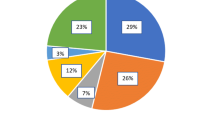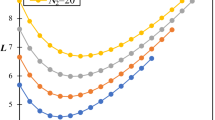Abstract
In this study, a continuous review (s,Q) inventory system with a service facility is examined. There is only one server and a limited number of customers waiting rooms in this facility. The demands arrive to the queueing-inventory system according to the Poisson process. Every customer needs a single product with a service period that is unpredictable and distributed arbitrarily. An external supplier replenishes the inventory, and the lead time for the reorder is predicated on an independent exponential distribution. Demands that arise during a stock out period must wait in the waiting area, and when the ordered items arrive, they are served using the first-come-first-serve queueing discipline. With the help of the imbedded Markov chain technique, we are able to compute the joint probability distribution of the number of customers in the system and the number of items in inventory at post-departure epoch. With the remaining service time of a customer in service as the supplementary variable, we are able to relate the system length distributions at post-departure and random epochs in order to determine the joint probability distribution at random epoch. The analysis of waiting time of an accepted customer in the queue is also examined. Several stationary system performance measures are computed and the total expected cost is determined under an appropriate cost structure to determine the optimal values for waiting space (N), reorder level (s), and order quantity (Q). In order to explain the important performance indicators of the system, some numerical findings are given for a variety of model parameters.

Similar content being viewed by others
References
Arun, C. P. (2000). Queueing and inventory theory in clinical practice: Application to clinical toxicology. Annals of the New York Academy of Sciences, 919(1), 284–287.
Baek, J. W., & Moon, S. K. (2014). The \(M/M/1\) queue with a production-inventory system and lost sales. Applied Mathematics and Computation, 233, 534–544.
Berman, O., Kaplan, E. H., & Shevishak, D. G. (1993). Deterministic approximations for inventory management at service facilities. IIE Transactions, 25(5), 98–104.
Berman, O., & Kim, E. (1999). Stochastic models for inventory management at service facilities. Stochastic Models, 15(4), 695–718.
Berman, O., & Kim, E. (2001). Dynamic order replenishment policy in internet-based supply chains. Mathematical Methods of Operations Research, 53(3), 371–390.
Berman, O., & Kim, E. (2004). Dynamic inventory strategies for profit maximization in a service facility with stochastic service, demand and lead time. Mathematical Methods of Operations Research, 60(3), 497–521.
Berman, O., & Sapna, K. P. (2000). Inventory management at service facilities for systems with arbitrarily distributed service times. Stochastic Models, 16(3–4), 343–360.
Berman, O., & Sapna, K. P. (2001). Optimal control of service for facilities holding inventory. Computers and Operations Research, 28(5), 429–441.
Berman, O., & Sapna, K. P. (2002). Optimal service rates of a service facility with perishable inventory items. Naval Research Logistics, 49(5), 464–482.
Chakravarthy, S. R. (2020). Queueing-inventory models with batch demands and positive service times. Automation and Remote Control, 81(4), 713–730.
Chakravarthy, S. R., & Rumyantsev, A. (2020). Analytical and simulation studies of queueing-inventory models with MAP demands in batches and positive phase type services. Simulation Modelling Practice and Theory, 103, 102092.
Keerthana, M., Sangeetha, N., & Sivakumar, B. (2022). Optimal service rates of a queueing inventory system with finite waiting hall, arbitrary service times and positive lead times. Annals of Operations Research. https://doi.org/10.1007/s10479-022-04901-2
Keerthana, M., Saranya, N., & Sivakumar, B. (2020). A stochastic queueing-inventory system with renewal demands and positive lead time. European Journal of Industrial Engineering, 14(4), 443–484.
Kim, E. (2005). Optimal inventory replenishment policy for a queueing system with finite waiting room capacity. European Journal of Operational Research, 161(1), 256–274.
Krishnamoorthy, A., Shajin, D., & Lakshmy, B. (2016). On a queueing-inventory with reservation, cancellation, common life time and retrial. Annals of Operations Research, 247(1), 365–389.
Krishnamoorthy, A., Shajin, D., & Narayanan, W. (2021). Inventory with positive service time: A survey. Advanced Trends in Queueing Theory, 2, 201–238.
Krishnamoorthy, A., & Viswanath, N. C. (2013). Stochastic decomposition in production inventory with service time. European Journal of Operational Research, 228(2), 358–366.
Melikov, A. Z., & Molchanov, A. A. (1992). Stock optimization in transportation/storage systems. Cybernetics and Systems Analysis, 28(3), 484–487.
Nair, A. N., Jacob, M. J., & Krishnamoorthy, A. (2015). The multi server \(M/M/(s, S)\) queueing inventory system. Annals of Operations Research, 233(1), 321–333.
Saffari, M., Asmussen, S., & Haji, R. (2013). The \(M/M/1\) queue with inventory, lost sale, and general lead times. Queueing Systems, 75(1), 65–77.
Satheesh Kumar, R., & Elango, C. (2012). Markov decision processes in service facilities holding perishable inventory. Opsearch, 49(4), 348–365.
Schwarz, M., & Daduna, H. (2006). Queueing systems with inventory management with random lead times and with back ordering. Mathematical Methods of Operations Research, 64(3), 383–414.
Schwarz, M., Sauer, C., Daduna, H., Kulik, R., & Szekli, R. (2006). \(M/M/1\) Queueing systems with inventory. Queueing Systems, 54(1), 55–78.
Shajin, D., Jacob, J., & Krishnamoorthy, A. (2022). On a queueing inventory problem with necessary and optional inventories. Annals of Operations Research, 315(2), 2089–2114.
Sigman, K., & Simchi-Levi, D. (1992). Light traffic heuristic for an \(M/G/1\) queue with limited inventory. Annals of Operations Research, 40(1), 371–380.
Zhao, N., & Lian, Z. (2011). A queueing-inventory system with two classes of customers. International Journal of Production Economics, 129(1), 225–231.
Zhang, Y., Yue, D., & Yue, W. (2022). A queueing-inventory system with random order size policy and server vacations. Annals of Operations Research, 310, 595–620.
Acknowledgements
The first and third authors acknowledge the National Board for Higher Mathematics (NBHM), DAE, Mumbai, India, for financial support from the project grant 02012/1/2019 NBHM(R.P)/R &D II/1231.
Author information
Authors and Affiliations
Corresponding author
Ethics declarations
Conflict of interest
The authors declare that they have no conflict of interest.
Additional information
Publisher's Note
Springer Nature remains neutral with regard to jurisdictional claims in published maps and institutional affiliations.
Appendices
Appendix A: Develop system of differential-difference equations
Relating the states of the system at time epochs t and \(t+dt\), we easily derive the following steady-state system of differential-difference equations as
Multiplying (A8) and (A22) by \(e^{-\alpha x}\) and integrating them w.r.t. x over 0 to \(\infty \), we obtain
Appendix B: Derivation of \(\pi ^{*(1)}(i,j,0)\)
The first order derivative \(\pi ^{*(1)}(i,j,0)\) of \(\pi ^{*}(i,j,\alpha )\) at \(\alpha =0\) are obtained from (A23), (A24), (A25), (A26), (A27), (A29), (A30), (A32), (A33), (A35) and (A36) as
Appendix C: Derivation of \(\pi ^{*}(i,j,\theta )\) and \(\pi ^{*(1)}(i,j,\theta )\)
The \(\pi ^{*}(i,j,\theta )\) and \(\pi ^{*(1)}(i,j,\theta )\) are obtained from (A23), (A24), (A26), (A27), (A29), (A30), (A32), (A33), (A35) and (A36) as
Appendix D: Derivation of \(G^{*(n)}(\alpha )\) at \(\alpha =\theta \) for deterministic, exponential and Erlang service time distributions
Deterministic distribution
Let \(g(t)=1\) for \(t=1/\mu \) and 0 in all other cases. Thus, \(g^{*(n)}(\alpha )=\frac{(-1)^n}{\mu ^n}e^{-\alpha /\mu }\).
Then \(G(t)=1\) for \(0\le t\le 1/\mu \) and 0 in all other cases. Thus, \(G^{*(n)}(\alpha )=\frac{(-1)^{n}n!}{\alpha ^{n+1}}\Bigg [1-e^{-\alpha /\mu }\sum _{i=0}^n\frac{1}{i!}\bigg (\frac{\alpha }{\mu }\bigg )^i\Bigg ]\).
Exponential distribution
Let \(g(t)=\mu e^{-\mu t}\). Thus, \(g^{*(n)}(\alpha )=\frac{(-1)^{n}n!\mu }{(\alpha +\mu )^{n+1}}\). Then \(G(t)=e^{-\mu t}\). Thus, \(G^{*(n)}(\alpha )=\frac{(-1)^{n}n!}{(\alpha +\mu )^{n+1}}\).
Erlang (of order p) distribution
Let \(g(t)=\frac{\mu ^pt^{p-1}e^{-\mu t}}{(p-1)!}\). Thus, \(g^{*(n)}(\alpha )=\frac{(-1)^{n}\mu ^p(n+p-1)!}{(p-1)!(\alpha +\mu )^{n+p}}\). Then \(G(t)=\sum _{i=0}^{p-1}\frac{(\mu t)^ie^{-\mu t}}{i!}\).
Thus, \(G^{*(n)}(\alpha )=\frac{(-1)^{n}n!}{\alpha ^{n+1}}\Bigg [1-\bigg (\frac{\mu }{\alpha +\mu }\bigg )^p\sum _{i=0}^n{i+p-1\atopwithdelims ()i}\bigg (\frac{\alpha }{\alpha +\mu }\bigg )^i\Bigg ]\).
Rights and permissions
Springer Nature or its licensor (e.g. a society or other partner) holds exclusive rights to this article under a publishing agreement with the author(s) or other rightsholder(s); author self-archiving of the accepted manuscript version of this article is solely governed by the terms of such publishing agreement and applicable law.
About this article
Cite this article
Samanta, S.K., Isotupa, K.P.S. & Verma, A. Continuous review (s, Q) inventory system at a service facility with positive order lead times. Ann Oper Res 331, 1007–1028 (2023). https://doi.org/10.1007/s10479-023-05171-2
Accepted:
Published:
Issue Date:
DOI: https://doi.org/10.1007/s10479-023-05171-2
Keywords
- Positive lead time
- Cost analysis
- Stochastic service time
- (s
- Q) Inventory policy
- Queueing-inventory system




